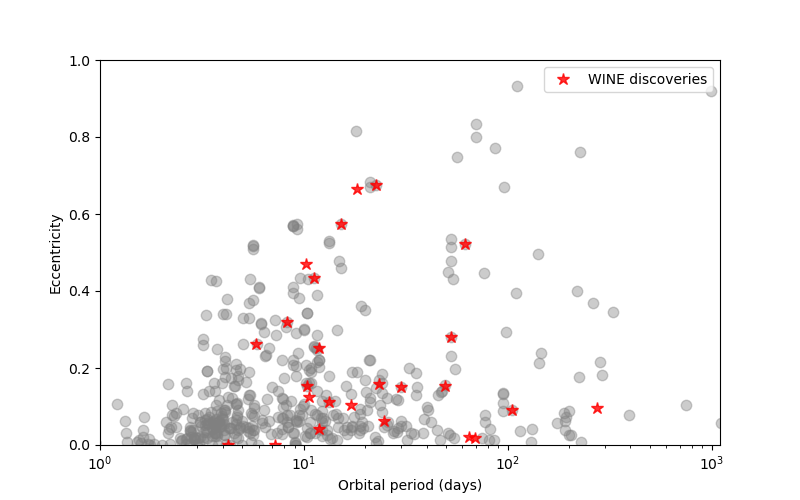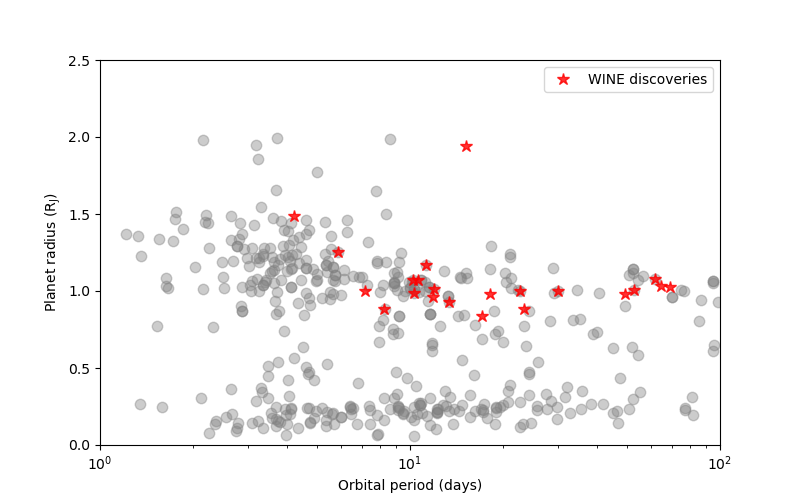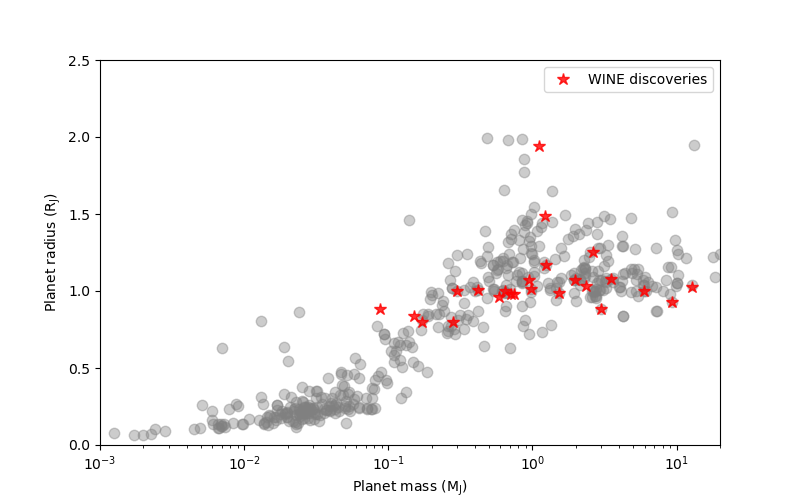The WINE collaboration: a Warm Giants planets survey
- 1Universidad Adolfo Ibañez, Facultad de Ingeniería y Ciencias, Chile
- 2ESO, Chile
The large number and diversity of exoplanets found in the last decades has raised fundamental questions about their formation and evolution mechanisms.
Many of these are giant planets orbiting very close to their host star, hence their name Hot Jupiters, despite the low occurrence rate of such population (Stevenson 1982; Mayor et al. 2011, Fressin et al. 2013, Santerne et al. 2016). This is mainly driven by the inherent observational bias in their detection, given their small periods, which results in a dominant population of Hot Jupiters which is about 75% of the detected exoplanets. Most of such discoveries arose from wide-field ground-based observatories (Bakos et al. 2006, Mandushev et al. 2005, Udalski et al. 2002), from the Kepler and K2 space missions (Borucki 2017, Howell et al. 2014) and, more recently, from the Transiting Exoplanet Survey Satellite mission (TESS, Ricker et al. 2015).
Giant planets are thought to form via two different mechanisms: either by accreting its mass from the proto-planetary disk (Pollack et al. 1996), or by gravitational instabilities, in which the proto-planetary disk fragments into bound clumps to form a planet (Cameron 1978). Both mechanisms predict low formation rate at close-in orbits. Close to the star gas conditions could prevent the formation of bound clumps (Rafikov 2005), while at the same time such conditions may prevent the formation of sufficient large cores to accrete gas from the proto-planetary disk (Schlichting 2014).
Therefore, the observed population of Hot Jupiters strongly suggests that they might have formed further out, in regions where the conditions for core accretion and gravitational instabilities are more favorable, and migrated inwards into their currently close-in circular orbits.
Possible migration mechanisms consider interactions with the disc (e.g. Walsh et al. 2011) and tidal migration produced by changes in the orbit, which can be induced by planet-planet scattering (Rasio & Ford 1996) or cyclic and/or chaotic secular interactions (Kozai 1962, Lidov 1962, Wu & Lithwick 2011).
Therefore, the observed population of Hot Jupiters strongly suggests that they might have formed further out, in regions where the conditions for core accretion and gravitational instabilities are more favorable, and migrated inwards into their currently close-in circular orbits.
Both mechanisms predict different orbital parameters for the planet population. While disc migration predict mainly circular orbits aligned with the stellar spin, high eccentricity migration predict a wide distribution of eccentriticies and obliquities (Chatterjee et al. 2008).
In this context, the estimation of the bulk structures and atmospheric parameters of such population of exoplanets could provide crucial information about their formation locations in the disc and possible migration paths (Madhusudhan et al. 2014, Mollière et al. 2022).
However, the characterization of the formation history of Hot Jupiters, widely defined as planets with periods smaller than 10 days, can be problematic, as their proximity to their host star may induce radiative and tidal interactions which can affect the interpretation of the origins of the observed population (e.g. Albrecht et al. 2012).
Therefore, giant planets within the snow-line, but at farther distances from their host star, represent a unique opportunity to study possible formation and migration mechanisms in giant planets, as they may not be affected by their proximity to their host star, allowing a more direct comparison of their orbital properties with formation and migration models.
Warm giants, planets broadly defined as planets orbiting their host star with periods longer than 10 days, remained elusive to ground-based transit searches, mainly due to the constrains imposed by the daily cycle. While some detections were possible with the Kepler+K2 missions (i.e. Huang et al. 2016), only with TESS it has been possible to systematically characterize them, either through the detection of periodic transiting signals or single transiters (i.e. Brahm et al. 2019, Gill et al. 2020).
By complementing transit observations with radial velocity (RV) measurements, it is possible to provide a detailed characterization of the dynamical properties of the planetary system.
The Warm gIaNts with TESS (WINE) collaboration is a dedicated survey to identify, confirm and characterize warm giants using TESS data and ground-based photometric and spectroscopic follow-up facilities, with the main goal of building a giant planets database to constrain theories of planetary formation and evolution. We have detected more than 20 Warm giants (Kossakowski et al. 2019, Jordán et al. 2020, Brahm et al. 2020, Schleker et al. 2020, Hobson et al. 2021, Trifonov et al. 2021 and 2023, Brahm, et al. 2023, Hobson et al. 2023, Jones et al. 2024) and we have been following-up dozens of exoplanet candidates. Among our discoveries we highlight the detection of several high eccentricity exoplanets, which are ideal candidates to measure their obliquity using the Rossiter-Maclaughlin effect, and determine the 3D exoplanetary orbits and properly constrain planetary migration theories. The figures show the orbital period-eccentricity diagram, the orbital period-planet radius diagram and the planetary mass-radius diagram where we highlight the discoveries made by our collaboration.



How to cite: Tala Pinto, M., Brahm, R., Jones, M., and Jordán, A.: The WINE collaboration: a Warm Giants planets survey, Europlanet Science Congress 2024, Berlin, Germany, 8–13 Sep 2024, EPSC2024-578, https://doi.org/10.5194/epsc2024-578, 2024.